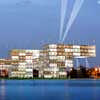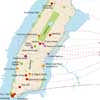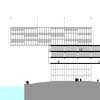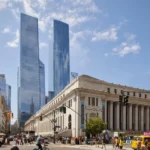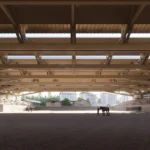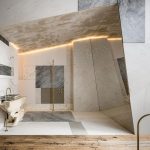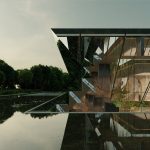Nieuw Amsterdam, New York Building, Buiksloterham Project, Design, Image
Nieuw Amsterdam Manhattan : Buiksloterham Development
Nieuw Amsterdam – design by morePlatz architects
Feb 4, 2010
Nieuw Amsterdam
Design: morePlatz
Nieuw Amsterdam – Re-importing NY
The concept for the project is based on the historic link between Manhattan and Amsterdam. Manhattan’s very beginning, its urban development and its programmatic richness serve as a reference on three levels.
The paradoxical task of creating an ‘Open Fort’ leads to an elevated structure that is bold and emblematic but at the same time allowing for maximum accessibility of the IJ-oevers and visual connections with the city centre of Amsterdam across the river.
1 Urban Level – ‘Urban Initiator’
Starting from the nucleus of ‘Fort Amsterdam’, the settlement that became Manhattan experienced a novel dynamic and growth and developed a whole new idea of what a city can be like.
Like the former ‘Fort Amsterdam’, the project’s role as ‘Urban Initiator’ is designed to have a stimulating effect on the development of the ‘Buiksloterham’ area.
2 Programmatic Level – ‘Incubator’
Specific NYC landmarks and programs serve as inspiration for the programmatic composition of the 24.000 m2 GFA. A compilation of metropolitan functions is transferred to ‘Nieuw Amsterdam’.
The project hosts all the functions that new citizens need to get settled / started in Amsterdam North:
– available small scale office spaces for startups
– housing equipped for temporary stay (furnished, boarding houses)
– services and public functions (city register, housing agency, job agency, leisure, retail, language school, cultural institutions etc.)
– open waterfront and public space that facilitates sports and and social activities
3 Building Level and Site – ‘Grid and Park’
The basic urbanist element that enabled and enhanced the speed and scope of NY’s growth is the grid. Being non-hierarchic the grid allows for maximum diversity and compatibility.
For ‘Nieuw Amsterdam’ a certain part of the Manhattan grid is projected onto the site in scale 1/10, making it applicable for the design and organization of the new building. The projection maintains the actual orientation of the grid, resulting in the building’s angular position to the Distelweg and Johan van Hasselt canal. It strengthens the iconic quality of the free-standing volume and allows for maximum exposure to the riverbanks and its surroundings. The composition of unfolding open angles and the lifting of the building give maximum views towards Amsterdam from the apartments.
The general proportions of the NY grid of 1 by 3 are kept throughout the whole design. The down-scaled grid used for the design is 8.1m x 24.3m. (All internal organization, wall partitions, parking, vierendeel structure and facades are based on denominators of 1.35m, 2.7m, 5.4m which allows efficient planning)
The programm is allocated in three zones of distinct layers: the ‘pillars’, the ‘folded slab’ and the ‘tentacles’.
Sliced into three voxels (3D pixels) these elements reflect the logo of the City of Amsterdam – 3 crosses revisited.
The building is located in the centre of a park. Freely designed Public Space surrounds the grid-based building. The park accommodates leisure facilities, fountains, a meandering promenade, the ‘riverside drive’ and access to the marina.
sustainability
Aiming for a very efficient and sustainable usage of energy and installations a system of thermo-activated construction units is proposed.
Heat is produced by a heat pump system which is fed by underground water.
A system of thermo-activated construction units, such as floor-slabs and massive walls, distributes heat. During summer the same system is used for cooling. The required cooling energy is stored in the mass of the building. The system is additionally fed by renewable energy from solar panels on the roof.
Ventilation
All floors comprise a separate air filled layer (plenum) which is provided with fresh air from air treatment units. Customized arrangement of air nozzles creates comfortable air quality / room climate.
Sunscreen
External sunshades on the outer layer of the perimeter balconies create an efficient climate buffer. The perforated steel mesh construction produces a cooling ‘chimney effect’ along the facade.
Nieuw Amsterdam Manhattan images / information from morePlatz architects
Location: New York City, USA
New York City Architecture
Contemporary New York Buildings
NYC Architecture Designs – chronological list
New York City Architecture Tours by e-architect
New Amsterdam Plein
UNStudio
New Amsterdam Pavilion
The Standard
Todd Schliemann of Polshek Partnership Architects
The Standard New York
23 East 22nd Street, Flatiron district
OMA
23 East 22nd Street
Comments / photos for the Nieuw Amsterdam New York Architecture page welcome

